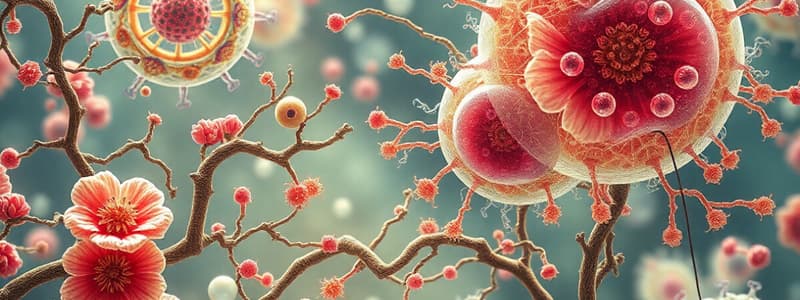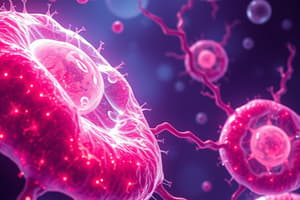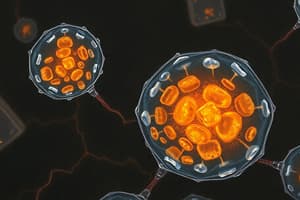Podcast
Questions and Answers
What primarily initiates the development of specialized cells in the human body?
What primarily initiates the development of specialized cells in the human body?
- Proliferation of embryonic cells (correct)
- Differentiation of adult tissues
- Injury to existing cells
- Apoptosis of stem cells
What is the relationship between cell differentiation and the rate of proliferation?
What is the relationship between cell differentiation and the rate of proliferation?
- Proliferation increases as differentiation occurs
- Proliferation decreases as cells differentiate (correct)
- There is no correlation between differentiation and proliferation
- Differentiated cells consistently divide rapidly
Which type of cells is able to re-enter the cell cycle after differentiation?
Which type of cells is able to re-enter the cell cycle after differentiation?
- Undifferentiated stem cells
- Highly specialized nerve cells
- All differentiated cells
- Some differentiated cells, such as fibroblasts (correct)
In the context of maintaining adult tissues, what role do stem cells primarily serve?
In the context of maintaining adult tissues, what role do stem cells primarily serve?
Which statement is false regarding the characteristics of differentiated cells?
Which statement is false regarding the characteristics of differentiated cells?
What is the primary function of PDGF in the context of fibroblast activity?
What is the primary function of PDGF in the context of fibroblast activity?
Which of the following cell types is capable of proliferating to form new blood vessels during tissue repair?
Which of the following cell types is capable of proliferating to form new blood vessels during tissue repair?
Which factor is primarily released in response to low oxygen levels to promote endothelial cell proliferation?
Which factor is primarily released in response to low oxygen levels to promote endothelial cell proliferation?
In the context of liver regeneration, what is the initial state of liver cells before they proliferate?
In the context of liver regeneration, what is the initial state of liver cells before they proliferate?
Which of the following cell types is explicitly stated as being unable to divide after differentiation?
Which of the following cell types is explicitly stated as being unable to divide after differentiation?
Which type of stem cell can give rise to any cell type?
Which type of stem cell can give rise to any cell type?
What is the primary characteristic of adult stem cells?
What is the primary characteristic of adult stem cells?
Which type of stem cell is derived from reprogrammed adult somatic cells?
Which type of stem cell is derived from reprogrammed adult somatic cells?
What is the origin of totipotent stem cells?
What is the origin of totipotent stem cells?
In the context of stem cells, what is the key limitation of hematopoietic stem cells?
In the context of stem cells, what is the key limitation of hematopoietic stem cells?
What is the primary role of skin stem cells in the epidermis?
What is the primary role of skin stem cells in the epidermis?
Where are satellite cells located in skeletal muscle tissue?
Where are satellite cells located in skeletal muscle tissue?
What is a key characteristic of stem cells?
What is a key characteristic of stem cells?
What distinguishes transit-amplifying cells from stem cells in the skin?
What distinguishes transit-amplifying cells from stem cells in the skin?
What is the turnover rate of epidermal cells in the skin?
What is the turnover rate of epidermal cells in the skin?
What is the primary role of hematopoietic stem cells (HSCs)?
What is the primary role of hematopoietic stem cells (HSCs)?
During what process do intestinal stem cells primarily contribute to cell renewal?
During what process do intestinal stem cells primarily contribute to cell renewal?
Which type of stem cells are responsible for the production of hair shafts?
Which type of stem cells are responsible for the production of hair shafts?
Why are most fully differentiated cells considered terminally differentiated?
Why are most fully differentiated cells considered terminally differentiated?
What is a key characteristic of skeletal muscle tissue regarding cell turnover?
What is a key characteristic of skeletal muscle tissue regarding cell turnover?
What distinguishes transit-amplifying cells from stem cells in the intestinal epithelium?
What distinguishes transit-amplifying cells from stem cells in the intestinal epithelium?
What is the potential medical application of adult stem cells in treating disorders?
What is the potential medical application of adult stem cells in treating disorders?
Which of the following describes the renewal process of hematopoietic stem cells?
Which of the following describes the renewal process of hematopoietic stem cells?
What triggers the activation of satellite cells in skeletal muscle?
What triggers the activation of satellite cells in skeletal muscle?
In which area of the body are intestinal stem cells primarily located?
In which area of the body are intestinal stem cells primarily located?
How are skin stem cells significant to tissue maintenance?
How are skin stem cells significant to tissue maintenance?
What happens to blood cells that have reached the end of their lifespan?
What happens to blood cells that have reached the end of their lifespan?
Flashcards
Stem Cells (SCs)
Stem Cells (SCs)
A cell that can divide and differentiate into specialized cell types, forming various tissues and organs. They are crucial for tissue repair and maintenance throughout life.
Cell Proliferation
Cell Proliferation
The process of cell division and growth, leading to an increase in the number of cells within an organism.
Programmed Cell Death
Programmed Cell Death
The programmed death of cells, a crucial process for development and maintaining tissue homeostasis.
G0 phase
G0 phase
Signup and view all the flashcards
Cell Differentiation
Cell Differentiation
Signup and view all the flashcards
Fibroblast Proliferation
Fibroblast Proliferation
Signup and view all the flashcards
Endothelial Cell Proliferation
Endothelial Cell Proliferation
Signup and view all the flashcards
Liver Regeneration
Liver Regeneration
Signup and view all the flashcards
Proliferation of Differentiated Cells
Proliferation of Differentiated Cells
Signup and view all the flashcards
Non-Dividing Differentiated Cells
Non-Dividing Differentiated Cells
Signup and view all the flashcards
What is the potency of adult stem cells?
What is the potency of adult stem cells?
Signup and view all the flashcards
What is the potency of embryonic stem cells?
What is the potency of embryonic stem cells?
Signup and view all the flashcards
How are iPS cells created?
How are iPS cells created?
Signup and view all the flashcards
What is the potency of zygote stem cells?
What is the potency of zygote stem cells?
Signup and view all the flashcards
What is the current status of medical applications for adult stem cells?
What is the current status of medical applications for adult stem cells?
Signup and view all the flashcards
Epidermal Stem Cells
Epidermal Stem Cells
Signup and view all the flashcards
Hair Follicle Stem Cells
Hair Follicle Stem Cells
Signup and view all the flashcards
Sebaceous Gland Stem Cells
Sebaceous Gland Stem Cells
Signup and view all the flashcards
Skeletal Muscle Stem Cells
Skeletal Muscle Stem Cells
Signup and view all the flashcards
Stem Cell Proliferation
Stem Cell Proliferation
Signup and view all the flashcards
Stem Cell Differentiation
Stem Cell Differentiation
Signup and view all the flashcards
Tissue Repair Potential
Tissue Repair Potential
Signup and view all the flashcards
Stem Cells
Stem Cells
Signup and view all the flashcards
Terminally Differentiated Cells
Terminally Differentiated Cells
Signup and view all the flashcards
Self-Renewal
Self-Renewal
Signup and view all the flashcards
Proliferation
Proliferation
Signup and view all the flashcards
Transit-Amplifying Cells
Transit-Amplifying Cells
Signup and view all the flashcards
Hematopoietic Stem Cells (HSCs)
Hematopoietic Stem Cells (HSCs)
Signup and view all the flashcards
Hematopoiesis
Hematopoiesis
Signup and view all the flashcards
Intestinal Stem Cells
Intestinal Stem Cells
Signup and view all the flashcards
Skin Stem Cells
Skin Stem Cells
Signup and view all the flashcards
Differentiation
Differentiation
Signup and view all the flashcards
Study Notes
Cell Renewal
- The human body has 1014 cells and 200 differentiated cell types.
- All cell types originate from a single cell.
- Cell proliferation and death are balanced throughout the lifetime of a multicellular organism.
- Homeostasis is a balance between cell death and proliferation.
- Cell death includes apoptosis and necrosis.
Introduction
- Embryonic development starts with rapid proliferation of embryonic cells.
- These cells then differentiate to form specialized adult tissues and organs.
- As cells differentiate, the rate of proliferation decreases.
Proliferation of Differentiated Cells
- Some differentiated cells retain their ability to divide.
- Examples of such include fibroblasts (in connective tissue, like skin fibroblasts and in blood vessels), as well as cells in some internal organs, like the liver.
- Other differentiated cells are unable to divide, including skeletal muscle cells.
- Less differentiated cells and self-renewing stem cells are responsible for replacing cells lost due to injury or programmed cell death, and for maintaining tissues and organs.
Stem Cells
- Stem cells have a critical role in maintaining most tissues and organs.
- Stem cells have the capacity to proliferate.
- Stem cells replace differentiated cells throughout the lifetime of an animal.
- The key property of stem cells is that one stem cell divides to produce one stem cell and one differentiated cell.
- Stem cells are self-renewing populations that produce differentiated cells throughout life.
- Stem cells play a significant role in tissues with short-lived cells like blood cells and skin and digestive tract epithelial cells.
- Hematopoietic stem cells (HSCs) were first identified in 1961 by McCulloch and Till.
- A single cell from mouse bone marrow can proliferate and differentiate into various blood cells.
- HSCs are well-characterized.
- All blood cells have limited lifespans (less than a day to a few months). Over 100 billion blood cells are lost and replaced daily in humans.
- HSCs continue to proliferate.
- They differentiate into specific pathways.
- They are influenced by factors.
- Intestinal epithelial cells are exposed to a harsh environment and live only a few days before shedding into the digestive tract.
- Renewal of intestinal epithelium is a continuous process throughout life.
- New cells form from the continuous (but slow) division of stem cells located at the bottom of intestinal crypts.
- Transit-amplifying cells arise from stem cells and divide rapidly, creating further differentiated cells.
Skin Stem Cells
- Skin cells are continuously renewed throughout life.
- Skin stem cells are responsible for continuous renewal of skin and hair.
- Skin and hair are exposed to harsh external environments, like UV radiation.
- Each cell line in skin is maintained by its own stem cells.
- The epidermis is a multi-layered epithelium that turns over every 2 weeks.
- Cells are replaced by epidermal stem cells in the basal layer.
- Stem cells give rise to transit-amplifying cells that divide in the basal layer.
- Differentiated cells move outward to form the surface of the skin.
- Hair is produced from stem cells in the hair follicles, located in the bulge.
- Bulge stem cells give rise to transit-amplifying cells, which proliferate and then differentiate to form the hair shaft.
- Sebaceous gland cells are produced from stem cells located in the base of the sebaceous gland.
Skeletal Muscle Stem Cells
- Skeletal muscle is typically stable, with low turnover.
- It regenerates rapidly in response to injury or exercise.
- Regeneration comes from muscle stem cells called satellite cells.
- Satellite cells are typically arrested in G0.
- However, they can be activated to proliferate in response to injury or exercise.
- Activated satellite cells give rise to progeny (more specialized cells) , divide several times, and differentiate and fuse to form new muscle fibers.
Medical Applications of Adult Stem Cells
- Adult stem cells have the potential to repair damaged tissue, and to replace damaged tissue and treat various disorders, like diabetes, muscular dystrophy, Parkinson's, and Alzheimer's disease.
- Bone marrow transplantation is a well-established clinical application.
Types of Stem Cell
- Adult stem cells that renew organs are multipotent. These are derived from adult tissues, organs, or blood.
- Embryonic stem cells are pluripotent, derived from the blastocyst.
- Induced pluripotent stem cells (iPS cells) are pluripotent, reprogrammed somatic cells (meaning they come from the body and not from a blastocyst as with embryonic cells).
- Zygote stem cells are totipotent, coming from the zygote. This means they are the most versatile stem cells capable of differentiating into any cell type in the body.
Studying That Suits You
Use AI to generate personalized quizzes and flashcards to suit your learning preferences.



